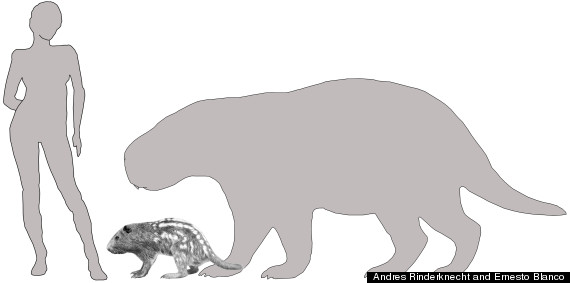
When scientists discovered the fossilized skull of a huge prehistoric rodent six years ago in Uruguay, they could tell right away that the extinct buffalo-sized creature had freakishly large incisors.
But a new analysis of the specimen of Josephoartigasia monesi -- believed to be the "the largest rodent ever to have lived" -- reveals that this ancient relative of the guinea pig used its gigantic teeth for more than delivering a powerful bite.
“We concluded that Josephoartigasia must have used its incisors for activities other than biting, such as digging in the ground for food, or defending itself from predators," Dr. Philip Cox, a professor of physiology at the University of York and Hull York Medical School in England, who led the research, said in a written statement. "This is very similar to how a modern day elephant uses its tusks."
(Story continues below image.)
Comparison of a silhouette of Josephoartigasia monesi with a person and a drawing of a modern-day pacarana, its closest living relative.
Josephoartigasia monesi is believed to have lived in South America around 3 million years ago and to have weighed around 1,000 kilograms.
For their analysis, the researchers used CT scans of the fossil to build a virtual reconstruction of the skull. Then they used the reconstruction and computer modeling to simulate the animal's bite and teeth.

Josephoartigasia monesi fossils used in the research.
The simulations showed that the rodent's bite was as powerful as a modern-day tiger's and that its teeth were extremely strong. Those findings suggest that the ancient animal could have used its teeth for more than just chewing, Science magazine reported.
The new research was published online in the Journal of Anatomy on Feb. 4, 2015.
Want to see some other monstrous prehistoric mammals? Check out the "Talk Nerdy To Me" episode below.
